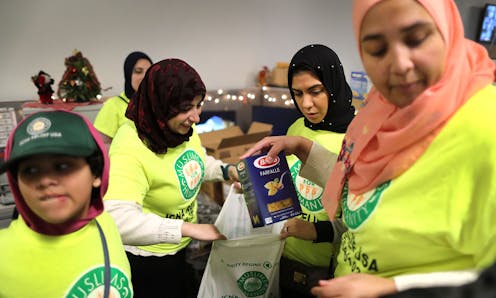How Muslim Americans meet their charitable obligations: 3 findings from new research
- Written by Shariq Siddiqui, Assistant Professor & Director of the Muslim Philanthropy Initiative, IUPUI

Zakat[1], one of the five pillars of Islam[2], is an obligatory act of giving and among several distinct forms of Islamic charity[3]. The Quran and hadiths[4], the words and sayings of the Prophet Muhammad, prescribe what kind of charitable causes are eligible to receive these funds.
Although Muslims are expected to give away 2.5% of their wealth every year, there is no time of year officially designated for Zakat. Yet, many Muslim Americans fulfill this mandatory charitable obligation during Ramadan[5], a monthlong period of fasting and spiritual growth.
Muslim Americans gave US$1.8 billion in Zakat funds in 2021[6], we found in new research regarding how and where Muslim Americans give Zakat[7]. We – three[8] scholars[9] of philanthropy[10] – surveyed a representative sample of 1,005 Muslim Americans.
We estimate that Zakat accounts for around 40% of total U.S. Muslim giving, based on the results of an earlier related study[11] completed in 2021. Here are three key findings from our latest research about how Muslim Americans approach this charitable tradition today.
1. Zakat is both formal and informal
Muslims primarily support formal charities and government entities, but they also give informally. This generally happens either by dispatching money to loved ones in other countries, in payments known as remittances[12], or giving money directly to people in need.
Some 25.3% of the money U.S. Muslims give as Zakat goes to international organizations, 21.7% supports governments and 18.3% flows to domestic-focused U.S. nonprofits. In addition, 14.7% of the money is given informally to individual people, often relatives, while 12.7% is sent abroad as remittances. The rest, about 7%, supports miscellaneous other kinds of causes.
Finding that more than 1 in 4 Zakat dollars are given informally surprised us. That’s because prior research had suggested that after 9/11, Muslims faced legal pressure[13] to only fund certified charitable organizations[14].
The U.S. government claimed for years that some Muslim charities and funding networks were financially supporting extremist organizations. This presumption cultivated a climate of fear and suspicion and stoked heightened U.S. surveillance[15], as well as waves of fear-mongering[16] toward Muslim charities. Yet, despite these pressures to formalize charitable giving, we find that Zakat giving continues to operate significantly through informal means.
2. Zakat reflects the ethnic and socioeconomic diversity of U.S. Muslims
The nearly 3.5 million Muslim Americans comprise only 1.1% of the nation’s population[17] but are demographically diverse – including African Americans, Latinos, Arabs, Asians and whites, with no one ethnic group comprising a majority. Some 58% of U.S. Muslims were born in other countries[18].
Despite having the same level of education as the general population, U.S. Muslims are nevertheless disproportionately poor[19].
We found that white Muslims gave the most to charity as Zakat: a mean of $3,732. Asian Muslims were next, giving an average of $1,089. Arabs averaged $569 in gifts, and African Americans gave an average of $420. People of mixed ethnicity averaged $336.
U.S. Muslims in their 40s gave an average of $2,560 in Zakat annually, followed by $2,298 for those between the ages of 18 and 29. Muslim Americans who were in their 30s gave $1,799, those 65 and older $1,074. Interestingly, we found that those who were 50-64 years old gave the least: $474 on average.
3. Zakat consists of a wide range of acts
We also found that Muslims consider philanthropy to consist of a wide range of acts that go beyond giving money.
In addition to volunteering or in-kind donations, these other forms of philanthropy include actions such as smiling[20], doing something for others out of good intentions, helping relatives, encouraging proper behavior, furthering good causes, abstaining from harmful acts and advocating on behalf of the oppressed. The Prophet Muhammad reportedly said that “smiling in the face of your brother is an of act of charity[21].”
Many Muslims see this broad understanding of philanthropy as essential to their social and civic participation. This model comes from the Prophet Muhammad, who espoused giving to charity – known as Sadaqa[22] in Arabic.
The next phase of this research will analyze how race, gender and Islamic theological traditions impact Muslim American giving practices.
References
- ^ Zakat (theconversation.com)
- ^ five pillars of Islam (theconversation.com)
- ^ Islamic charity (uwt.org)
- ^ hadiths (www.learnreligions.com)
- ^ Ramadan (theconversation.com)
- ^ US$1.8 billion in Zakat funds in 2021 (hdl.handle.net)
- ^ how and where Muslim Americans give Zakat (scholarworks.iupui.edu)
- ^ three (scholar.google.com)
- ^ scholars (scholar.google.com)
- ^ philanthropy (scholar.google.com)
- ^ earlier related study (theconversation.com)
- ^ known as remittances (theconversation.com)
- ^ legal pressure (www.aclu.org)
- ^ certified charitable organizations (theintercept.com)
- ^ heightened U.S. surveillance (theconversation.com)
- ^ fear-mongering (anthropology.mit.edu)
- ^ 1.1% of the nation’s population (www.pewresearch.org)
- ^ 58% of U.S. Muslims were born in other countries (www.pewresearch.org)
- ^ disproportionately poor (www.ispu.org)
- ^ actions such as smiling (islamonline.net)
- ^ smiling in the face of your brother is an of act of charity (sunnah.com)
- ^ Sadaqa (www.zakat.org)
Authors: Shariq Siddiqui, Assistant Professor & Director of the Muslim Philanthropy Initiative, IUPUI

